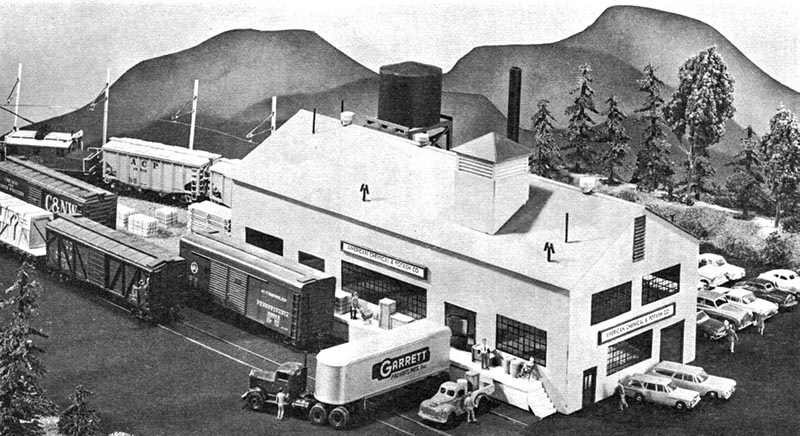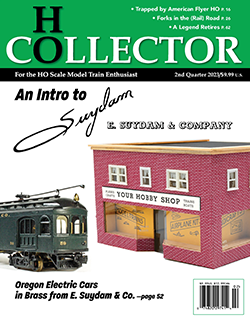 by Tony Cook/photos by the author
by Tony Cook/photos by the author
The first reference I find for the E. Suydam & Co. brand comes in spring 1951 in an ad (shown on the next page) calling the attention of “the serious model railroader” to an all-metal corrugated factory building. The $3.75 kit is promoted as “the building kit you have been waiting for!” In Model Railroader’s May 1951 edition, a review appeared in the magazine’s “Trade Topics” section covering this initial offering. The review stated the metal factory kit is Suydam’s first model railroad kit and noted the structure is based on a Glendale, Calif., furniture factory located along Southern Pacific. The comments bestowed on this metal kit by Model Railroader include calling it a “honey,” “good looking” and also noted this “is a kit for those who enjoy taking time to build a good model, and we think this type of modeler will find the results well worth the eight to ten hours required.” E. Suydam & Co. followed up its Furniture Factory with a Machine Works kit (also made of corrugated metal sheets). As it began its journey in the hobby, Suydam was based in Pasadena, Calif. The initial E in the company name stood for “Ed.”
In late 1952, Ed Suydam authored “Pacific Electric Interurban” for December’s Model Railroader. With his own brass replicas several years away from market, Suydam shared his passion for this type of railroading and detailed his build of Pacific Electric cars made from then-new John A. English & Co. metal body coach cars. Suydam’s kitbashed creation included reversing headlights, interior illumination, and seating detail, and the model was powered by a Lindsay L-140 unit. Suydam’s article includes a listing of materials and their costs. In addition to the mentioned English and Lindsay components, the power car and non-powered trailer car included Ayres Scale Models, Roundhouse/Model Die Casting, and Walthers parts. The power car’s bill totalled $31.75 and the trailer was assembled at a cost of $11.05.
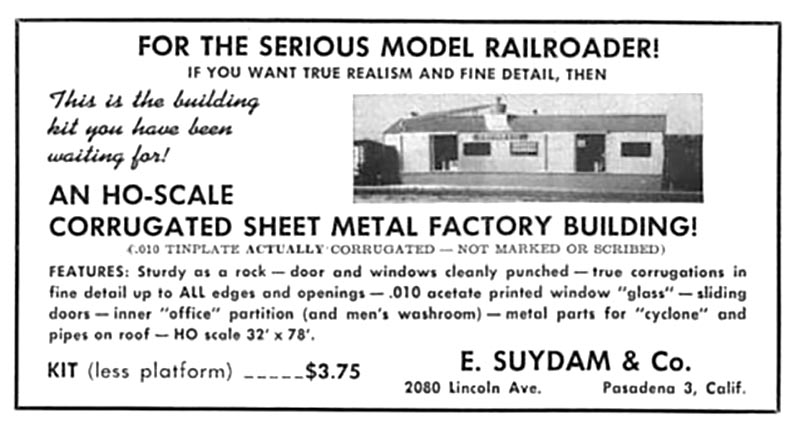
ABOVE: Spring 1951 brings this advertisement promoting E. Suydam & Co. and its first kit release. The Furniture Factory, made of corrugated metal and selling for $3.75, was “the building kit you have been waiting for!” The ad includes Suydam’s original Pasadena, Calif., address.
In spring 1953, Suydam branched out from its corrugated metal series and introduced a Modern Stucco House kit. Selling for $1.95, this kit included die-cut mat board and wood components with clear acetate window material, and some molded-plastic pieces. As the company did with a line of corrugated metal sheets for scratchbuilding needs, the move into mat board included similar sheet selections. In fall 1953, a news item report stated Suydam was developing a wooden signal tower suggestive of Southern Pacific design and would be released in HO and O. At the same time, Suydam offered its Furniture Factory in O scale. In mid-1954, Suydam launched its “Main Street” series with a Hobby Shop offering. The $2.25 release used the mat board and wood approach for its components.
With interurban service shown serving it, Suydam’s Branchline Station joined the “Main Street” series in fall 1954, which included the debut Hobby Shop release and the company’s Follies Theatre kit. It’s at this point, Suydam’s business address moved from Pasadena to Duarte, Calif. In 1955, the company sponsored a photo contest with prizes of $50, $25, and $15 for the winning model photos. Suydam expanded its offerings in late 1955 with news of its acquisition of “Argy” or “Agry” (both spellings appear in the same ad) and “Ed-Lee”freight car kits. I believe the reference is to Argy Specialties, which I traced to 1950 for a first sighting in any publication. Argy was a Fresno, Calif., company and the familiar Purina Chows Feed Mill (Suydam’s Kit 82) and Swift Meat Packing Plant (Suydam’s Kit 85) are an example of Argy-heritage items that moved to Suydam in the mid-1950s.
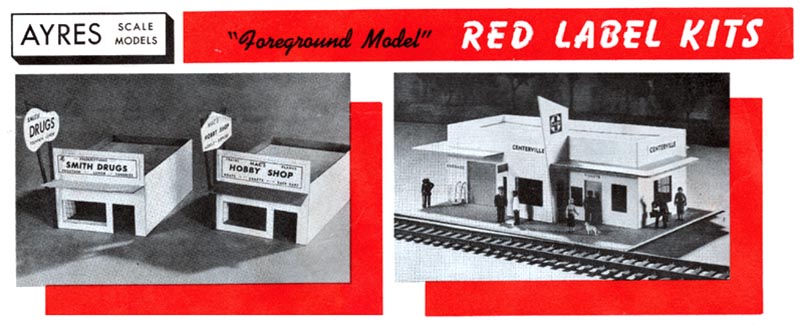
ABOVE: Ayres employed red as its packaging color and promoted select releases, like its Two Modern Stores and Modern Station as “Red Label” offerings. In the move to Suydam’s line, the 500-series stock numbering was retained and you’ll find examples of these kits with red box lids, yet labeled Suydam. This Modern Station was another release I always associated with E. Suydam & Co., and was surprised to learn about its heritage.
An early 1956 Suydam ad promotes its Ed-Lee Kits line with three rolling stock options displayed that included an Illinois Central express reefer, NADX egg reefer, and Pollock hot metal car. The Illinois Central reefer release (Kit MB-5 selling for $3.45) is noted as “just released” in the advertisement’s text.
In fall 1956, Suydam ventured into new territory as a company and doubt-less answered a close-to-home request for quality replicas of interurban equipment with news of the line’s first HO-scale brass imports. Billed as “exciting news,” the release was a big change for E. Suydam & Co. Selling for $29.95 and $21.50 respectively were Pacific Electric powered coach and non-powered trailer replicas. The models, imported from Japan, were assembled, presented in brass finish and ready for operation, and noted as “designed to please the discriminating model fan.” More brass imports of interurbans continued to arrive from Japan for Suydam’s line in 1957 with Niles and other prototypes joining the catalog. There is some variation to the production runs — the line’s Niles 1907 interurban saw an upgrade following its introduction that brought improved Baldwin trucks with accurate wheelbase for the second run.
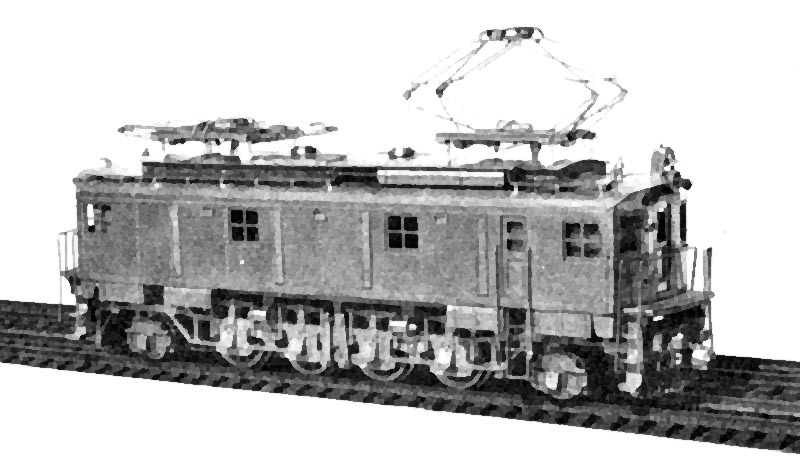
ABOVE: The company had been in business for about five years, when it expanded from structure kits into HO electrics. Bigger electrics came in the mid-1960s, like this Great Northern Z-1 box cab. The brass replica possessed an eight-wheel drive.
Late 1957 brought a Butte, Anaconda & Pacific box cab electric locomotive to the line. The prototype was an 80-ton General Electric product built in the early 1920s. Structure kits continued to see new releases from Suydam in the late 1950s. The company’s interurban electric interest brought a Power Sub-Station kit in fall 1958.
A mid-1959 advertisement served as an open letter to HO modelers and commented on comments expressing concerns over the state of the hobby. Sound familiar? In this situation, the rise of ready-to-run entry-level product seemed to have been causing worry about where HO was heading. Suydam, with its craftsman-level structure kits and brass electrics, appeared firmly in the camp of the serious pursuer of model railroading. The line’s offerings took a leap in size in late summer 1959 with the news that Suydam acquired Ayres Scale Models from Tru-Scale Models.
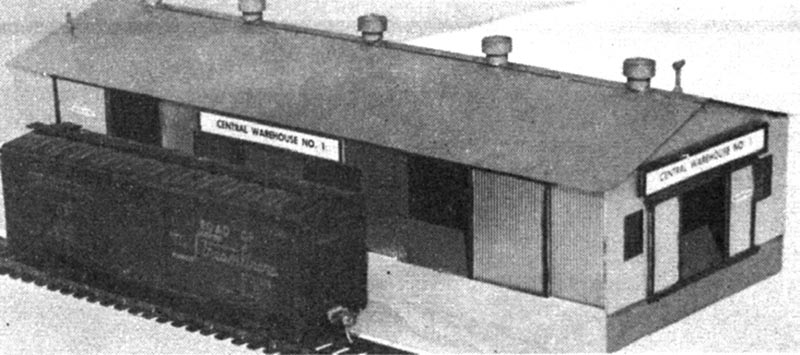
ABOVE: Suydam enjoyed good utility from sections of corrugated metal and conjured up a variety of structure kits for the HO market in the early 1950s. Suydam’s Warehouse (Kit 7) is shown above and provided trackside interest and a location for operations on a model railroad.
As the 1960s opened, Suydam marked its 10th anniversary and imported one of its most impressive brass electric locomotives. Great Northern’s Z-1 class box cab sold for $42.50 and reproduced a 47-foot Baldwin-Westinghouse prototype. An unpowered Z-1 was also offered and sold for $29.95. Built in the late 1920s, Great Northern owned 10 examples. In Model Railroader’s March 1960 review, the model is praised as “prime quality” though its pilot wheels are noted as being troublesome on sharp curves and the provided dummy Zamac couplers are dubbed “poor quality.” In general, this Japanese import was another positive for Suydam’s catalog and the review concludes by saying, “we heartily recommend it.” Illinois Terminal’s Class C and Pacific Electric Steeple Cab electric locomotives were equally impressive and debuted in spring 1960.
Much smaller but equally valuable, Suydam introduced brass-cased lamps for installation in model railroad control boards in mid-1960. The 12-volt incandescent lamps came in amber, clear, green, and red, and a half dozen cost $1.25. The structure line gained a new series of “E-Z To Build” house kits. Suydam marketed this trio (kits 54A, 54B, and 54C) as bridging the gap between “train set railroading” and “model railroading.” The kits retailed for $2.95 and included printed walls, acetate windows with curtains, and plastic windows and doors. The company’s brass imports expanded to Chicago prototypes with a Chicago, North Shore & Milwaukee powered combine selling for $29.95. Going beyond the interurban electric field, Suydam’s Brill gas-electric doodlebug (retailing for $43.50 and introduced in late 1960) was another impressive add to the line and hobby…


